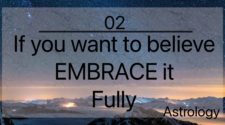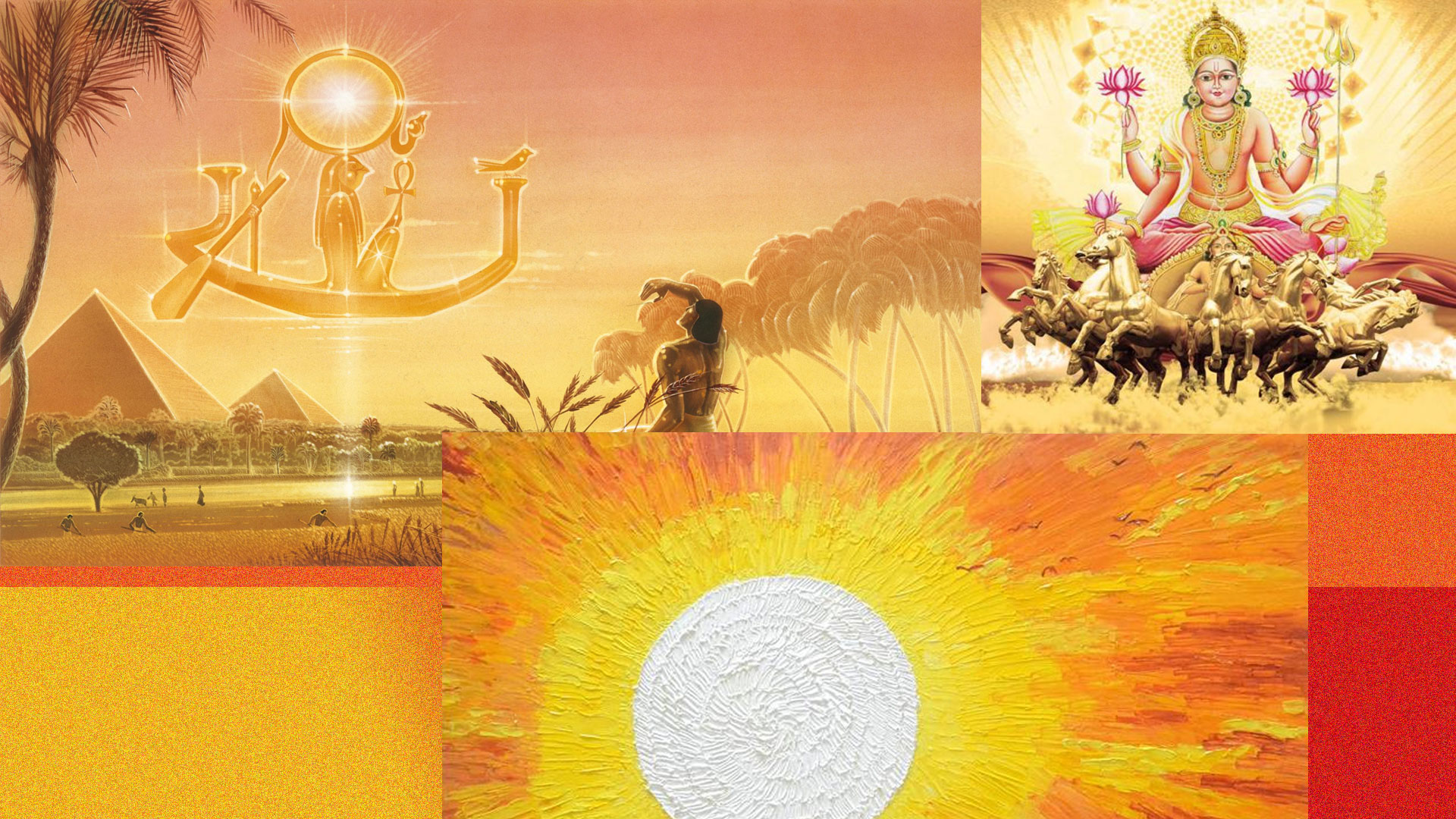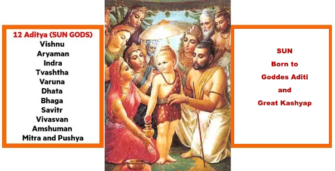For us earthlings, everything revolves around our lovely star Sun. Every civilization on earth, by some or the other way, kept Sun at their heart. As societies progressed, some of them sidelined him, some did not.
Some societies still pray to Sun, either directly or indirectly. At least they have a ‘halo’ behind the head of their Gods.
Vedic deity Sun also suffers the same tragic destiny. Once, the topmost God, along with Indra, Sun was progressively sidelined. Rigveda has Indra and 33 gods occupying all the prime cabinet positions. By the time we reach the following Vedas, we slowly move to the holy trinity of Brahma-Vishnu-Mahesh and 33 crore gods. Indra and his cabinet have their role to play. Still, the glorious positions they enjoyed in Rigveda do not exist anymore.
Sun, whom Brahma created as per instruction from primordial parents. Born to the great Kashyap and Mother Aditi, the Sun has been highly radiant, bedazzling. Born to Aditi, he is called the first Aditya (there are another 11). Driven on a chariot pulled by 7 horses, he moves across the skies, travels, creating the day and night on earth and the other seasons.
With his wife Sanjana (Vishwakarma’s daughter), he has three children: the current Manu and Yama and Yami’s twins. Sun’s brilliance causes a problem for Sanjana. She cannot bear it and requests her father for a solution. Vishwakarma, the celestial craftsman, architect to help his daughter chips off some of the Sun’s brilliance. Now being frugal to the core as any Indian, Vishwakarma would not waste this chipped of brilliance, that too of the most powerful deity. He put his skills to use and made various weapons for the rest of the Gods. Shiva’s trident, Vishnu’s chakra, and Kartikeya’s spear all emerge from this chipped matter.
Despite the new hairdo, Sun did reduce his brilliance, but still, Sanjana could not bear him. The Indian Nari went back to her parents’ home. However, while leaving, Sanjana created her shadow ‘Chaya’ and left her behind to serve her Husband.
Sun, oblivious to all these happenings, begets more children from Chaya, Svarani Manu, Shani, Tapti, Vishti.
Later on, in various Puranas, we get different accounts of how planets are born of the Sun (not his children). Mercury, Venus, Mars, Jupiter are all from the Sun, except Moon-whom we get from Samudra Manthan. As for Rahu-Ketu (Swarbhanu), the Daityas, born from other wives of Kashyapa. So far, we can observe everything even in Vedic stories revolves around Sun.
Let’s try and explore a bit of the meaning. Sun created by the Brahma is way too brilliant for anyone to handle. That’s the King’s curse; nothing can outshine him. Thus being with the Sun, everything else loses its sheen. His heat can burn all that comes close to him. That makes him not easily approachable; Sun is lonely. Sun with all the brilliance is the prime ego. As all the planets come from him, he is the natural King to them, while Rahu-Ketu, the Daityas, try and cause all possible Harm to him.
He is the King of planets, but he has given the rest gods the weapons that have become the identities of these Gods. Along with things in kind, his children from the very basis of Vedic philosophy, Shani lords over Karma, while Yama lords over death, and Manu forms the rules and regulations. Shani grants result during lifetime and Yama after death.
In Jyotish, Sun is treated as the soul, the keeper of conscience (Sanjna also written Sangya =conscience), and King of Planetary court. Any planet close to the Sun is not able to perform- same as Sanjna. Like big trees can’t grow under a giant Banyan tree, so do other planets suffer the fate. Though he is a father like to them, flourishing is destiny that one can achieve only away from Sun. His own son Shani doesn’t share a good relation with his father. Instead, Jyotish defines it as an almost bitter relation. Thus when Sun and Shani are close, the soul suffers and harms the Karma.
 Sun is also the beholder of all the knowledge there exists, and even that will ever exist. But gaining that knowledge from him is an arduous task. The issue is his radiance. Hanuman as a child, mistook the golden globe traveling across the skies as fruit and leaped to eat it. But was hit by the Vajra from Indra on his chin (Hanu) and fell to earth. In a fit of anger, Papa Vayu pulls back all the winds and air suffocating the earth, swearing to continue until the culprit is punished. To placate Vayu, all the gods bestow Hanuman with lots of powers. Happy Vayu gives in, and the world is saved. Also, the world is saved from Hanuman gulping the Sun. As a child, Hanuman thought Sun to be a fruit, same Hanuma pursued the Sun to be his Guru in later life.
Sun is also the beholder of all the knowledge there exists, and even that will ever exist. But gaining that knowledge from him is an arduous task. The issue is his radiance. Hanuman as a child, mistook the golden globe traveling across the skies as fruit and leaped to eat it. But was hit by the Vajra from Indra on his chin (Hanu) and fell to earth. In a fit of anger, Papa Vayu pulls back all the winds and air suffocating the earth, swearing to continue until the culprit is punished. To placate Vayu, all the gods bestow Hanuman with lots of powers. Happy Vayu gives in, and the world is saved. Also, the world is saved from Hanuman gulping the Sun. As a child, Hanuman thought Sun to be a fruit, same Hanuma pursued the Sun to be his Guru in later life.
Hanuman wouldn’t take a no from Sun. Sun kept explaining that he doesn’t have time, as he has to move constantly from east to west, and also, his irradiance cannot be handled by any living thing. Nobody can look towards the Sun continuously, even for few minutes, without being harmed. Hanuman told Sun that he can do it; Sun does not need to stop for him. Instead, Hanuman will fly ahead of Sun, facing Sun to learn all the knowledge. Finally, Sun gives in and teaches Hanuman all the knowledge. Thus Hanuman becomes the only one to possess all the knowledge that Sun has.
Thus through various stories, we can see how Sun always remains the center of our evolution and keeper of knowledge. And from such Sun all, almost every ancient civilization held him at a high position. Many may have lost him in the past, but the Indian continent still holds him in high regard. For otherworldly religion, he exists through symbolism, but on the Indian continent, he still is God.
The favorite color that today Hinduism identifies itself with also comes from Sun. Saffron/Bhagva color, which Bhagat Singh asked his clothes to be dowsed in, is the Sun’s creation. Now Sun is always described as bright red, golden yellow. In all his descriptions, one does not come across the Bhagva color, so where does it come from? Hint: it is an Illusion he creates twice a day.
















Interesting read,! amazing how the story of sun and wife Sanjana is relatable with astrological placement of planets near the sun
Yes Planets near Sun though do get power but it comes at cost.
transient nature of Gods and overall transient nature of hinduism , more articles like this please,, everyone should understand that what we believe today is not set in stone
Thank you. Yes there are more articles that will be following. Drop your suggestions too.
I would suggest exploring the planets in a similar way. Are they Gods, or which Gods control them, what is their backstory
Nice article,, keep up with such articles, at glance they seem trivial however the jog a part of the memory, and the symbolism of it all, it is a good reminder
Hey there! I have an interesting idea for you. How about writing an article on the ‘loneliness’ of the Sun? From both a philosophical point, and an astrological point of view. You can explore aspects like when two planets come in the same house, for instance, Sun + Mars, Sun + Mercury, etc. It would be fascinating to understand how the lonely and outshining Sun impacts the other planets in the same house!
Hi Niranjan,
Thank for the germ. I will consider it. Though Sun is never considered for ‘mind matters’, I will try and write about the dynamics of planets with Sun. Thanx once again